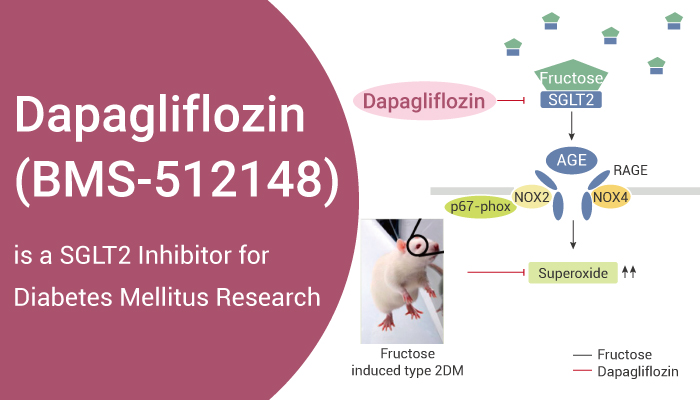SGLT2 (glucose cotransporter 2, also known as SLC5A2) is a member of the sodium-glucose cotransporter family and belongs to the sodium-dependent glucose transporters. SGLT2 is mostly located in the brush-like membranes of S1 and S2 segments in proximal renal tubular cells. In addition, SGLT2 is a glucose transporter mainly responsible for renal glucose reabsorption, with low affinity (K m ∼0.4 mm ), high capacity (filtering ∼180 g glucose per day), which makes its inhibitors can be used in the research of diabetes.

Dapagliflozin is a SGLT2 Inhibitor for Diabetes Mellitus Research
Dapagliflozin is a competitive glucose cotransporter 2 (SGLT2) inhibitor that causes excretion of glucose in the urine for the study of diabetes mellitus (DM), which induces HIF1 expression and attenuates renal IR (ischemia/reperfusion) injury. In some in vitro studies, Dapagliflozin (0-10 μM; 2 h) significantly increases the HIF1 expression in hypoxic HK2 cells and normoxic HK2 cells. Also it increases AMPK and EKR phosphorylation in hypoxic HK2 cells, but shows no effect on the phosphorylation of AMPK and ERK in normoxic HK2 cells. Moreover at 24 h, Dapagliflozin in a dose-dependent manner increases the cell survival in hypoxic HK2 cells. In some in vivo studies, Dapagliflozin (oral administration; 10 mg/kg) causes a marked increase in urinary glucose in SGLT2i-mice. Additionally it suppresses BAT thermogenesis by reducing sympathetic nerve activity and enhances hepatic gluconeogenesis and glycogenolysis.
In conclusion, as a competitive SGLT2 inhibitor, Dapagliflozin causes glucose excretion in urine and attenuates renal IR injury.
Reference:
[1] PLoS One. 2016 Mar ;11(3):e0150756.
[2] J Biol Chem. 2020 Oct ;295(42):14379-14390.